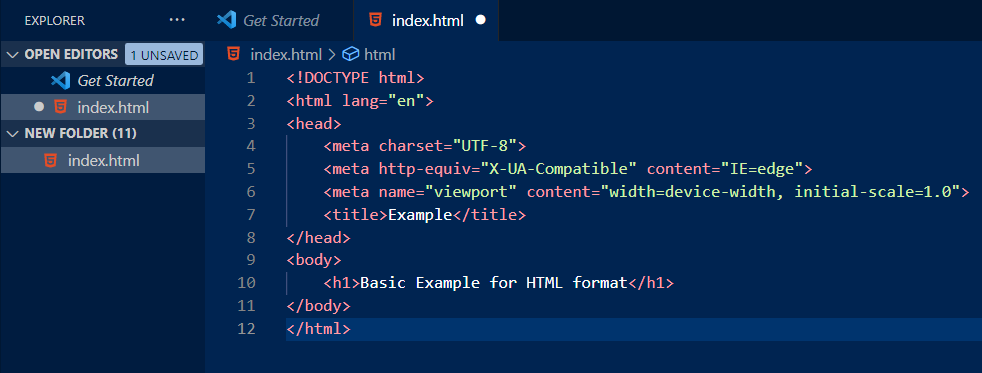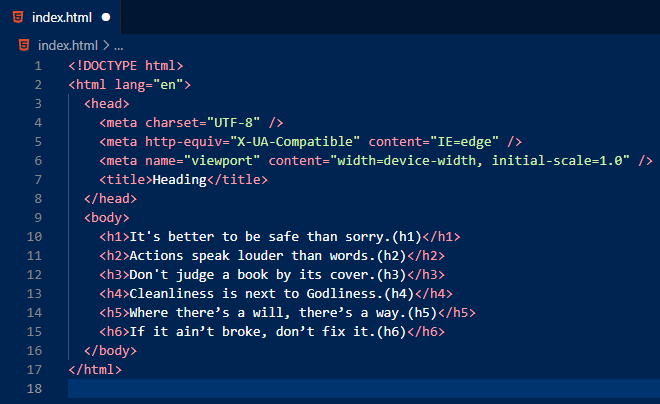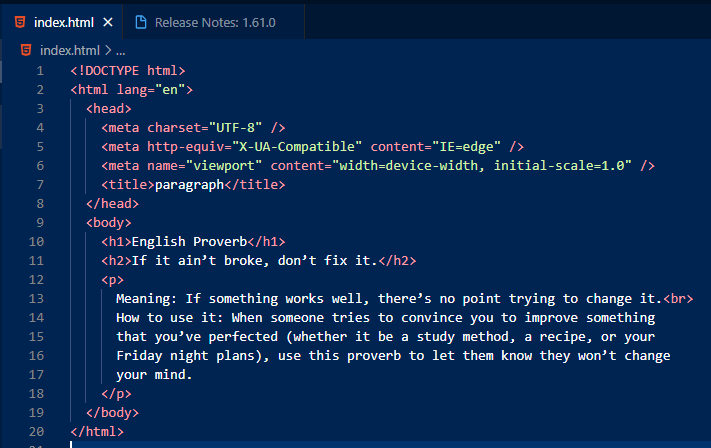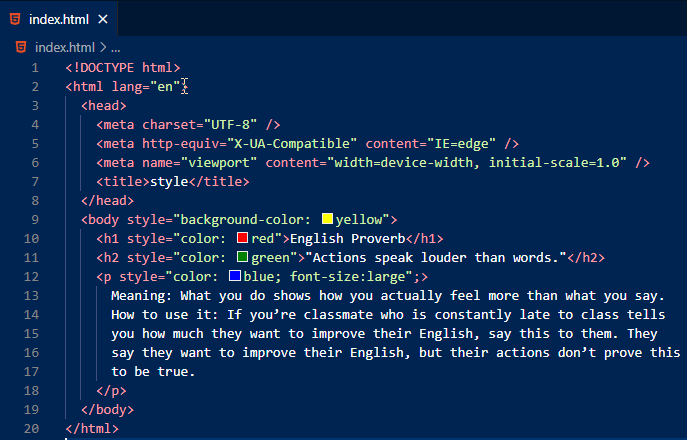| Tag |
Description |
| <!--...--> |
Defines a comment |
| <!DOCTYPE> |
Defines the document type |
| <a> |
Defines a hyperlink |
| <abbr> |
Defines an abbreviation or an acronym |
| <acronym> |
Not supported in HTML5. Use <abbr> instead. |
|
Defines an acronym |
| <address> |
Defines contact information for the author/owner of a document |
| <applet> |
Not supported in HTML5. Use <embed> or <object> instead. |
|
Defines an embedded applet |
| <area> |
Defines an area inside an image map |
| <article> |
Defines an article |
| <aside> |
Defines content aside from the page content |
| <audio> |
Defines embedded sound content |
| <b> |
Defines bold text |
| <base> |
Specifies the base URL/target for all relative URLs in a document |
| <basefont> |
Not supported in HTML5. Use CSS instead. |
|
Specifies a default color, size, and font for all text in a document |
| <bdi> |
Isolates a part of text that might be formatted in a different direction from other text outside it |
| <bdo> |
Overrides the current text direction |
| <big> |
Not supported in HTML5. Use CSS instead. |
|
Defines big text |
| <blockquote> |
Defines a section that is quoted from another source |
| <body> |
Defines the document's body |
| <br> |
Defines a single line break |
| <button> |
Defines a clickable button |
| <canvas> |
Used to draw graphics, on the fly, via scripting (usually JavaScript) |
| <caption> |
Defines a table caption |
| <center> |
Not supported in HTML5. Use CSS instead. |
|
Defines centered text |
| <cite> |
Defines the title of a work |
| <code> |
Defines a piece of computer code |
| <col> |
Specifies column properties for each column within a <colgroup> element |
| <colgroup> |
Specifies a group of one or more columns in a table for formatting |
| <data> |
Adds a machine-readable translation of a given content |
| <datalist> |
Specifies a list of pre-defined options for input controls |
| <dd> |
Defines a description/value of a term in a description list |
| <del> |
Defines text that has been deleted from a document |
| <details> |
Defines additional details that the user can view or hide |
| <dfn> |
Specifies a term that is going to be defined within the content |
| <dialog> |
Defines a dialog box or window |
| <dir> |
Not supported in HTML5. Use <ul> instead. |
|
Defines a directory list |
| <div> |
Defines a section in a document |
| <dl> |
Defines a description list |
| <dt> |
Defines a term/name in a description list |
| <em> |
Defines emphasized text |
| <embed> |
Defines a container for an external application |
| <fieldset> |
Groups related elements in a form |
| <figcaption> |
Defines a caption for a <figure> element |
| <figure> |
Specifies self-contained content |
| <font> |
Not supported in HTML5. Use CSS instead. |
|
Defines font, color, and size for text |
| <footer> |
Defines a footer for a document or section |
| <form> |
Defines an HTML form for user input |
| <frame> |
Not supported in HTML5. |
|
Defines a window (a frame) in a frameset |
| <frameset> |
Not supported in HTML5. |
|
Defines a set of frames |
| <h1> to <h6> |
Defines HTML headings |
| <head> |
Contains metadata/information for the document |
| <header> |
Defines a header for a document or section |
| <hr> |
Defines a thematic change in the content |
| <html> |
Defines the root of an HTML document |
| <i> |
Defines a part of text in an alternate voice or mood |
| <iframe> |
Defines an inline frame |
| <img> |
Defines an image |
| <input> |
Defines an input control |
| <ins> |
Defines a text that has been inserted into a document |
| <kbd> |
Defines keyboard input |
| <label> |
Defines a label for an <input> element |
| <legend> |
Defines a caption for a <fieldset> element |
| <li> |
Defines a list item |
| <link> |
Defines the relationship between a document and an external resource (most used to link to style sheets) |
| <main> |
Specifies the main content of a document |
| <map> |
Defines an image map |
| <mark> |
Defines marked/highlighted text |
| <meta> |
Defines metadata about an HTML document |
| <meter> |
Defines a scalar measurement within a known range (a gauge) |
| <nav> |
Defines navigation links |
| <noframes> |
Not supported in HTML5. |
|
Defines an alternate content for users that do not support frames |
| <noscript> |
Defines an alternate content for users that do not support client-side scripts |
| <object> |
Defines a container for an external application |
| <ol> |
Defines an ordered list |
| <optgroup> |
Defines a group of related options in a drop-down list |
| <option> |
Defines an option in a drop-down list |
| <output> |
Defines the result of a calculation |
| <p> |
Defines a paragraph |
| <param> |
Defines a parameter for an object |
| <picture> |
Defines a container for multiple image resources |
| <pre> |
Defines preformatted text |
| <progress> |
Represents the progress of a task |
| <q> |
Defines a short quotation |
| <rp> |
Defines what to show in browsers that do not support ruby annotations |
| <rt> |
Defines an explanation/pronunciation of characters (for East Asian typography) |
| <ruby> |
Defines a ruby annotation (for East Asian typography) |
| <s> |
Defines text that is no longer correct |
| <samp> |
Defines sample output from a computer program |
| <script> |
Defines a client-side script |
| <section> |
Defines a section in a document |
| <select> |
Defines a drop-down list |
| <small> |
Defines smaller text |
| <source> |
Defines multiple media resources for media elements (<video> and <audio>) |
| <span> |
Defines a section in a document |
| <strike> |
Not supported in HTML5. Use <del> or <s> instead. |
|
Defines strikethrough text |
| <strong> |
Defines important text |
| <style> |
Defines style information for a document |
| <sub> |
Defines subscripted text |
| <summary> |
Defines a visible heading for a <details> element |
| <sup> |
Defines superscripted text |
| <svg> |
Defines a container for SVG graphics |
| <table> |
Defines a table |
| <tbody> |
Groups the body content in a table |
| <td> |
Defines a cell in a table |
| <template> |
Defines a container for content that should be hidden when the page loads |
| <textarea> |
Defines a multiline input control (text area) |
| <tfoot> |
Groups the footer content in a table |
| <th> |
Defines a header cell in a table |
| <thead> |
Groups the header content in a table |
| <time> |
Defines a specific time (or datetime) |
| <title> |
Defines a title for the document |
| <tr> |
Defines a row in a table |
| <track> |
Defines text tracks for media elements (<video> and <audio>) |
| <tt> |
Not supported in HTML5. Use CSS instead. |
|
Defines teletype text |
| <u> |
Defines some text that is unarticulated and styled differently from normal text |
| <ul> |
Defines an unordered list |
| <var> |
Defines a variable |
| <video> |
Defines embedded video content |
| <wbr> |
Defines a possible line-break |








